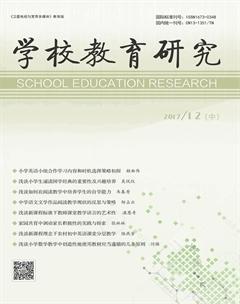Moudle5 A Trip Along the Three Gorges(Reading)
馬娣
一、教材依據(jù)
本節(jié)教學設計取材于外研社第四冊書第五模塊A Trip Along the Three Gorges中的閱讀。
二、教材分析
本節(jié)內容是以“旅游”為話題,旨在通過有關旅游景點的名勝古跡和風土人情,以及假日旅游、旅行游記等環(huán)節(jié)的學習,使學生在擴大詞匯量、提高英語水平的同時,豐富了地理和旅游知識,開擴了視野,更好地了解世界,培養(yǎng)了學生熱愛大自然、造福人類的高尚情操。
三、學情分析
本節(jié)的教學對象是高一學生,他們活潑熱情,對于旅行他們充滿向往。經(jīng)過高一一年的英語學習,知識儲備正在上升的過程,自我表達能力有所提升。興趣是最好的老師,基于此,本節(jié)課需最大發(fā)揮學生自主學習能力,讓他們有話可說,有料可寫。在探究和合作的愉快氛圍中完成學習目標。
四、教學目標(三維目標)
1.知識目標
讓學生掌握下列單詞、短語和句型。
重點單詞與短語:cave, peak, plain, plateau, shore, slope, valley, wood, flat, surround, hilly, raft, narrow, distant, exploit, at the edge of, at least, be heavy with
重點句子:(1)We could see the sun setting behind the white pagoda.
(2)Every ..., every stream that joined ..., every ... was heavy with the past.
(3)A distant mountain was a sign in 20-foot characters.
2.技能目標
(1)使學生會運用所學知識描繪旅行路線并簡單描述本文提及的三峽旅行圖。
(2)培養(yǎng)學生略讀、查讀的閱讀技能,進一步提升學生歸納總結、從文中獲取信息、處理信息的能力,從而培養(yǎng)提高學生的閱讀理解技巧。
3.情感目標
1(1)了解三峽秀美的地理風景及三峽大壩的建成,感受人類的開創(chuàng)的精神。
(2)讓學生在本文的學習中,享受閱讀的樂趣,熱愛大自然,增長知識。
五、教學重難點
基于以上教材分析,我將文章的重難點分析如下:
1. 訓練skimming, scanning , detailed reading及understanding 等閱讀技能;
2. 對文章深層次的理解及細節(jié)欣賞,掌握地道的英語。
3. 掌握完全倒裝句。
4. 深刻理解把握相關詞匯的含義,用法等。
5. 培養(yǎng)學生開闊視野,增長知識,熱愛大自然。
六、教學方法
通過新課標的學習,學生為主體,教師為主導成為一種教學趨勢和主流教學方法。為調動學生動口、動腦、動手,讓他們更多地參與教學,根據(jù)本課的教學目標、文章特點,基于對學生一定的了解,結合學生的實際及其心理特征,我采用以下方法進行教學:
直觀法:充分利用多媒體,引導學生熱身并漸入佳境。
速讀法:讓學生快速閱讀,以盡快了解文章大意。
問答法:幫助學生理解文章的細節(jié)。
總結歸納法:幫助學生鞏固所學知識,延伸積累。
七、教學過程
◆Step l Pre-reading
Ask Ss to answer several questions in order to introduce something about the Three Gorges. Let Ss read the poem together:
水調歌頭 游泳
才飲長江水, 又食武昌魚。
萬里長江橫渡, 極目楚天舒。
不管風吹浪打, 勝似閑庭信步, 今日得寬余。
子在川上曰:逝者如斯夫!
風檣動, 龜蛇靜, 起宏圖。
一橋飛架南北, 天塹變通途。
神女應無恙, 當今世界殊。
(1) Who wrote this poem ?
It was written by Mao Zedong on June 1956.
(2) What does it refer to ?
It refers to Mao Zedongs dream “walls of stone to hold back clouds and rain till a smooth lake rises in the narrow gorges.” Now his dream has come true.
(3) How much do you know about the Three Gorges ? S1, S2, S3
Then show Ss some pictures about the Three Gorges and introduce them in brief. ◆Step2 While-reading
Task l:fast reading抓主旨,搜信息
Skim the passage fast to get a general idea of the whole passage.While reading,try to finish the following tasks.
1) Fill in the form :
Answers: A holiday for Spring Festival
Peter and his colleague
By boat
Along the Three Gorges
2) Can you write out the route of the trip ?
Task2:Detailed reading 瞄細節(jié),深理解
1.Read the passage and choose the right statements about the writers journey
1) Peter and his friend went downstream ___.
(a) to see the dam (b) to see the Three Gorges (c) to get to Fuling
2) He chose the Jiangyou boat because____.
(a) it was crowded (b) it didnt stop at temples (c) it didnt usually carry foreigners
3) When they started the trip it was______.
(a) sunny (b) cold (c) evening
4)When the boat went through the first gorges, Peter and his friend ______.
(a) took lots of photographs (b) spent most of the time on deck (c) were asleep
5) When they reached the site of the dam ______ came to look.
(a) everyone (b) no one (c) only the foreigners
Answers: b c a c a
2. Ask Ss to listen to the text and answer the following questions
What they saw and what they did?
From Fuling to Fengdu:____________ _______________________
Along the Qutang Gorge:___________ ________________________
Alone the Wu Gorge: ______________ _______________________
Alone the Xiling Gorge: ____________________________________
Answers: bamboo rafts and coal boats on the river
narrow gorge, two-mile-high mountains
Wushan, Daning river, some smaller gorges, Wu gorge
Xiang River, rock, stream, hill, Xiling Gorge
Task 3:Further understanding 重難點,細體味
Lead students to focus on the understanding of some difficult words or sentences.
1. He and a colleague were to spend two years there teaching English at a teacher training college.
be to do something 表示“按照計劃或根據(jù)安排將要進行的動作”。
We were to go to the Great Wall next week.
我們打算下周去長城。
spend vt. 花費;耗費(時間、金錢等)。常用于spend ... on sth.與spend ... (in) doing sth.結構中。
[1] According to a recent U.S. survey, children spent up to 25 hours a week________ TV. (上海2004)
A. to watch B. to watching C. watching D. watch
[點撥] 選C。本題考查spend的用法:spend time (in) doing sth. 花費時間做某事。
2. 歸納下列各句中斜體詞的用法及含義
1) The gorge narrows to 350 feet as the river rushes through the two-mile-high mountains. (使……變窄)
2) The boss wanted to better the working conditions for his workers. (改善; 使……變好)
3) The nurse is calming the child in hospital. (使……平靜)
4) The little boys mother warned him not to dirty his clothes.
(使……臟; 把……弄臟)
規(guī)律總結: 以上各句均為形容詞活用作動詞, 表示“使……”
3. On a distant mountain was a sign in 20-foot characters. 此句為倒裝句, 正常語序為:A sign in 20-foot characters was on a distant mountain.
句型轉換:
On the top of the mountain stands a white pagoda.
A white pagoda stands on the top of the mountain.
4. At Wushan we made a detour up the Daning River to see some of the smaller gorges
1) make a detour 繞路而行, 繞道行走
2) up逆流而上; 表示 “順流而下”, 則用down
翻譯句子:
我們只好步行繞道上山。
We have to make a detour to walk up the hill.
5.英譯漢
1)We could see the sun setting behind the white pagoda.
我們可以看到太陽正向白塔后面落去
2)Every rock looked like a person or animal, every stream that joined the great river carried its legends, every hill was heavy with the past.
塊塊巨石形狀各異, 條條支流都流淌著傳說, 座座小山承載著過往。
◆Step 3 :Post-reading
Summary綜觀全文,把握細節(jié)
Ask Ss to fill in the blanks according to the text to learn the important words.
Peter and his colleague __(1)___the boat at Fuling. The sun was shining brightly _(2)__ they sailed __(3)___through a hilly region. As the sun _(4)___they _(5)____ at Fengdu.
They _(6)_____when they went through the first gorge, __(7)___ is called the Qutang Gorge. The gorge ___(8)__350 feet as the river _(9)__ through the two-mile-high mountains.
At Wushan they made a detour __(10)___the Daning River __(11)__ some smaller gorges. The next day they __(12)___ the Wu Gorge. They __(13)__ the Xiang River, home of QuYuan
As they __(14)__ the third gorge, the Xiling Gorge, they ___(15) the construction site of the dam, _(16)__ they saw the Chinese flag _(17)__ in the wind. (18)___a distant mountain __(19)__a sign ___(20)__20-foot characters
Answers: (1)got on (2)as (3)downstream (4)set (5)docked (6)slept (7)which (8)narrows to (9)rushes (10) up (11)to see (12)went through (13)passed (14)came out of (15)sailed into (16)where (17) blowing (18) On (19)was (20) in
◆Step 4 : Thinking and discussion 加深感悟,樹立遠大目標
(1)Ask Ss to discuss following questions.
What do you think of Peters trip ?
Would you like to go on a trip to the Three Gorges? Why?
What are you eager to see?
(2)Ask Ss to write 5 sentences to describe his or her trip.
八、教學反思
這堂課是一節(jié)閱讀課。課堂氛圍比較輕松,學生在自主、合作、探究的氣氛中愉快度過。同時,在老師循序漸進地引導下,學生有所談,有所想,有所思,有所悟。于此同時我有幾分感悟和思考。第一,課堂的導入很重要。作為老師的我們一定要在一堂課的前幾分鐘之內,充分調動學生的感官、緊緊抓住學生的心理和興趣,使學生活躍起來,快樂學習。這不由得讓我想起一句話“興趣是最好的老師”。第二,教學重難點突出,難點訓練及時有效,由易到難,層次分明。所設置的疑問或練習,多數(shù)學生都能順利完成。第三,整個教學準備過程充分體現(xiàn)了教師主導、學生主體的關系。學生積極思考談論,勇于表達自己的看法和觀點。課后討論中的問題很貼合我們生活本身,學生容易接受,也就有話可說。但是,本堂課也還存在一些不足,需要加以改進:由于本堂課任務多,容量大,導致完成任務時間較緊,某些任務余留的時間比較少,學生不能完全掌握所有的知識。今后會更加地合理安排時間,盡量做到精益求精,讓每個學生都充分融入課堂掌握新知識。

